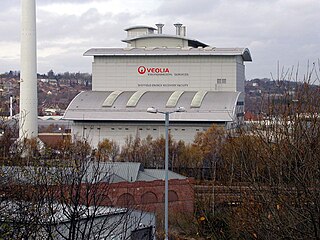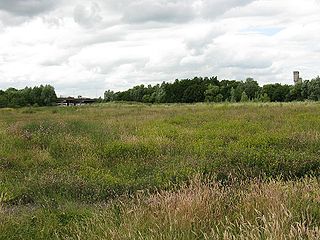
Incineration is a waste treatment process that involves the combustion of substances contained in waste materials. Industrial plants for waste incineration are commonly referred to as waste-to-energy facilities. Incineration and other high-temperature waste treatment systems are described as "thermal treatment". Incineration of waste materials converts the waste into ash, flue gas and heat. The ash is mostly formed by the inorganic constituents of the waste and may take the form of solid lumps or particulates carried by the flue gas. The flue gases must be cleaned of gaseous and particulate pollutants before they are dispersed into the atmosphere. In some cases, the heat that is generated by incineration can be used to generate electric power.

Waste-to-energy (WtE) or energy-from-waste (EfW) is the process of generating energy in the form of electricity and/or heat from the primary treatment of waste, or the processing of waste into a fuel source. WtE is a form of energy recovery. Most WtE processes generate electricity and/or heat directly through combustion, or produce a combustible fuel commodity, such as methane, methanol, ethanol or synthetic fuels.
The Kirklees EfW is a major moving grate incineration plant in Huddersfield, Kirklees, England. The incinerator is owned and operated by Suez Recycling and Recovery UK who signed a 25-year contract with Kirklees Council in 1998 with an option to increase the time period to 2028. The plant is integral to the waste strategy and Unitary Development plan of Kirklees Council, treating 150,000 tonnes of locally generated municipal waste, which when incinerated, will produce enough electricity to power 15,000 homes. Only 136,000 tonnes of waste is actually incinerated, the other tonnages permitted are recovered materials such as metals and Incinerator bottom ash (IBA) and Fly ash.
The Bolton WtE is a waste power station constructed in 1971 in Bolton, and is a major landmark of its skyline. The incinerator burns up to 20 tonnes of household waste per hour or 85,000 t per year, and can generate up to 11 MW of electricity. The plant is operated by Suez Recycling and Recovery UK. The Bolton incinerator is the only household waste incinerator in Greater Manchester.

The Sheffield Energy Recovery Facility, also known as the Energy from Waste Plant, is a modern incinerator which treats Sheffield's household waste. It is notable as it not only provides electricity from the combustion of waste but also supplies heat to a local district heating scheme, making it one of the most advanced, energy efficient incineration plants in the UK. In 2004, the district heating network prevented 15,108 tonnes of CO2 from being released from buildings across the city, compared to energy derived from fossil fuels. The incinerator is a 'static asset' owned by Sheffield City Council and operated by Veolia Environmental Services under a 35 year integrated waste management contract (IWMC)/PFI contract.

Cory Riverside Energy has operated a waste disposal since 2011 in the London Borough of Bexley. It collects rubbish by barge at riverside wharves and burns it at a waste-to-energy incinerator in Belvedere, London.

The Newhaven ERF is an incinerator, in the town of Newhaven in the English county of East Sussex, for the treatment of up to 210,000 tonnes per annum of the county's municipal solid waste. The facility, built by Veolia Environmental Services, was approved by planners at the Conservative-controlled East Sussex County Council.

The Newlincs EfW facility is an incinerator which is located in Grimsby, North East Lincolnshire, England. The plant is operated by Cyclerval UK & TIRU Group under a PFI contract. The engineering of the facility is unusual as it consists of an oscillating kiln handling 56,000 tonnes of waste per year/7 tonnes per hour of waste. The facility is capable of generating 3.2 MW electricity.

EcoPark is a waste-to-energy plant which burns waste from several London boroughs to provide electricity for the National Grid. It is located on the River Lee Navigation and bordered by the North Circular Road, in Edmonton in the London Borough of Enfield. It is also known as Edmonton EcoPark.
The Isle of Wight gasification facility is a municipal waste treatment plant in southern England. It entered the commissioning phase in autumn 2008, and will be replaced by a new moving grate incinerator in 2019

Teesside Energy from Waste plant is a municipal waste incinerator and waste-to-energy power station, which provides 29.2 megawatts (MW) of electricity for the National Grid by burning 390,000 tonnes of household and commercial waste a year. It is located on the River Tees at Haverton Hill, east of Billingham in North East England. Developed and built by NEM, a subsidiary of Northumbrian Water, the initial plant replaced the Portrack Incinerator and opened in 1998. Subsequently, the facility became part of SITA, now Suez.

The Portrack Incinerator was a municipal waste incinerator and waste-to-energy power station situated on the River Tees at Portrack in Stockton-on-Tees in County Durham, England.

Wheelabrator Baltimore is a waste-to-energy incinerator located in the Westport neighborhood of Baltimore, Maryland and is operated by Wheelabrator Technologies, a subsidiary of Energy Capital Partners. It has an electric generation capacity of 64.5 megawatts. On October 2, 2018, ECP announced the agreement to sell Wheelabrator Technologies to Macquarie Infrastructure Partners, a subsidiary of Macquarie Group.

It is estimated that 290 million tonnes of waste was produced in the United Kingdom in 2008 but volumes are declining. In 2012 municipal solid waste generation was almost 30 million tonnes, according to Waste Atlas Platform.

Wilmington is an industrial area east of the River Hull in Kingston upon Hull, England.

Marchwood ERF is a waste incineration plant in Marchwood, near Southampton, England. It is situated beside the estuary of the River Test where it meets Southampton Water, opposite the Port of Southampton. It burns municipal waste and produces electricity for the National Grid.

The Lakeside EfW is located in Colnbrook, Slough, and is the largest facility of its kind in England. It incinerates residual waste, and since 2010 it has also been authorised to incinerate low-level radioactive waste.
The anti-incinerator movement in China refers to the series of environmental protests that have occurred in opposition to China's numerous planned and operating industrial waste incinerators. The construction of these waste-to-energy facilities, which has prompted the ensuing protest movement, operates as part of China's ongoing efforts to restructure its waste disposal system in regard to its status as the largest producer of municipal solid waste worldwide since 2004. Described by some as being a new type of NIMBY protest, the roots of the anti-incinerator movement can be traced back to the early 1990s, following the introduction of China's first generation of incinerator plants. The movement, however, began in earnest with the benchmark 2006 Liulitun protest taking place in Beijing.

Allerton waste recovery park is a waste recovery and incineration site located on a former quarry at Allerton Mauleverer, near Knaresborough, England. It is operated by AmeyCespa on behalf of North Yorkshire County Council and City of York Council, the site is capable of handling 320,000 tonnes of household waste per year.
















